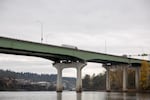
FILE - Traffic moves along Highway 26 heading into Portland, Ore., on Dec. 16, 2016. Oregon Department of Transportation is facing a funding shortage and says without a fix, drivers can expect “longer road closures, more trash and graffiti, worse winter driving conditions, more potholes, and slower DMV customer service.”
Don Ryan / AP
Oregon’s highway officials say they’re tapped out — and that’s about to mean big problems from metro Portland to Madras to Medford.
As inflation has sent road costs soaring in recent years, gas taxes are sputtering like an overworked Geo Metro. The funding pinch has grown so troublesome that the Oregon Department of Transportation warned last winter it couldn’t even plow mountain passes reliably without an emergency infusion of cash.
By 2027, the agency says, it will have to nix paving projects on any crumbling road that’s not a federal interstate. And without a radical funding fix, ODOT promises, you can expect “longer road closures, more trash and graffiti, worse winter driving conditions, more potholes, and slower DMV customer service.”
All Oregon needs to do to avoid this theoretical future? Pony up an extra $1.8 billion a year — plus a couple billion more to finish paying for megaprojects lawmakers promised seven years ago.
“These numbers are big,” ODOT Director Kris Strickler told lawmakers in February, offering a dire picture of his agency’s finances. “These numbers are really big. We know that.”
Oregonians are about to know it, too.
Next year, the question of how to ease ODOT’s woes promises to be one of the highest-profile — and most politically tricky — that will land on lawmakers’ desks.
To kick off the process, a committee of state senators and representatives has begun touring the state, soliciting opinions on how Oregon might spend any money from new taxes or fees.
They’ve so far heard pleas from the pragmatic to the fanciful. One man in Tillamook called for spruced-up highway rest areas, while some in Portland demanded a transit tunnel that could zip riders beneath downtown.
Related: Oregon lawmakers address transportation policy and hit the road
Splashy projects have been a cornerstone of past “transportation packages,” the term of art in Salem for bills that levy more money for roads. After all, bringing home a much-desired boon for their district is a time-tested way to get lawmakers on board with a tax increase.
But legislators and lobbyists who’ll be hashing out this year’s package insist this time is different.
“This really is a back-to-the-basics, fundamental transportation package going forward,” said Jim McCauley, a lobbyist for the League of Oregon Cities. “It’s not a lot of new bright shiny projects.”
Whether lawmakers can live up to that expectation remains to be seen. A key question heading into next year’s session is where the Legislature might look for money — and maybe more importantly, whether fractious lawmakers can find the will to vote such a proposal into law.
Here’s what you need to know as the conversation gets underway.
Why is ODOT short on money?
Oregon gets money for its roads from a huge variety of sources. The federal government chips in about $700 million a year. Taxes on Oregon employee payrolls, car dealers, and sales of new bicycles also generate money. But the main pot of funding ODOT uses is the State Highway Fund, made up of DMV fees, a weight-mile tax levied on heavy trucks, and money from fuel taxes like Oregon’s 40-cent-per-gallon gas tax.

Jason Stafford pumps gas into a car at Bend, Ore., gas station, July 5, 2024. Money from Oregon's gas tax supports the State Highway Fund, used by the Oregon Department of Transportation's for road maintenance projects.
Kathryn Styer Martínez / OPB
The fees and taxes that make up the highway fund aren’t indexed to inflation, which means the state’s buying power has withered as costs have soared in recent years.
Meanwhile, the state gas tax isn’t as potent as it used to be. As drivers buy more electric vehicles and cars with higher fuel efficiency, ODOT says it reaps about $40 a year less for every driver than it used to. (Other states and the federal government are facing a similar problem.)
That doesn’t mean gas taxes are down. The tax actually increased by two cents per gallon in January — a change set in motion in the Legislature’s 2017 transportation bill. According to the agency’s own estimates, ODOT expects revenue from fuels taxes to crest during the current fiscal year at about $694 million, before gradually declining moving forward.
Lastly, ODOT doesn’t get to keep all the money in the state highway fund. Cities and counties also get a share of the money to pay for their own roads.
So how much money are we talking about?
That depends on how you think about the problem.
In its February presentation to lawmakers, ODOT laid out a seemingly endless list of areas where it expects its next two-year budget to come up short. That includes a $205 million shortfall for basic operations and maintenance, and a nearly $1 billion hole in the annual amount ODOT says is necessary to repair decrepit roads and increase safety on its roadways.
To paper over all of its predicted funding gaps, ODOT says it will need an additional $1.8 billion a year.
Strickler, the agency’s director, told lawmakers ODOT will focus any new money first on maintenance priorities like plowing and re-striping roads, then on improved customer service, and last on safety improvements and road preservation.
That’s a departure from the state’s last transportation package in 2017, when big-ticket megaprojects dominated.

FILE - The Oregon Department of Transportation built a viaduct for bicycles and pedestrians along Summit Creek.
Kristian Foden-Vencil / OPB
“It’s a little awkward to be in front of you and not be asking for a bunch of projects,” Strickler said in the February hearing. “An agency director of a transportation agency always goes to the Legislature and says, ‘We need a bunch of projects.’”
Strickler would know — he has decades of experience in Oregon and Southwest Washington, including serving as project director of the failed megaproject known as the Columbia River Crossing that promised a new bridge on Interstate 5 connecting Oregon and Washington.
ODOT’s pledge that it wants to focus on the basics has found receptive ears.
“This is one time where you’ll find me almost being a shill for ‘Big Highway,’” said Sarah Iannarone, director of the Street Trust, a nonprofit that pushes safe streets for all modes of transportation. “I say fully fund the ODOT safety budget in addition to operations and maintenance. At the end of the day, I think every Oregonian who lives here and works here wants to see a sidewalk their kids can get to school on, and safe places for people to just get around their community.”
Didn’t you say something about incomplete highway projects?
Yep. Even if ODOT’s $1.8 billion figure is accurate, it’s not the full scope of the budget problem. The agency is also sitting on two massive projects that were promised when lawmakers last passed a transportation package in 2017, but are now in limbo.

FILE - The Interstate 205 Abernethy Bridge, seen from the Oregon City waterfront, in 2018.
Bryan Vance / OPB
One will ensure the Abernethy Bridge, where Interstate 205 crosses the Willamette River, can withstand an earthquake. Construction is already underway, but ODOT had been counting on tolling the bridge to come up with around half of its $750 million price tag. When Gov. Tina Kotek pulled the plug on the state’s tolling plans in March, that money disappeared.
ODOT is also a billion dollars short for its controversial plan to add auxiliary lanes to Interstate 5 as it passes through Portland’s Rose Quarter. The project is a longtime demand from business groups and the state’s trucking industry, who are furious construction hasn’t even begun.
“Our number-one priority is still sitting there in the same state it was,” said Jana Jarvis, president and CEO of the Oregon Trucking Associations. “Here we sit now seven years later. ODOT is coming back to say they don’t have enough money for that project. They don’t have enough for the other projects. They don’t have enough for maintenance.”
Related: A plan to toll Portland highways is dead — but tolling is still on the table
In fairness to ODOT, the Rose Quarter project has hardly been an easy task. It’s despised by climate advocates and other groups, who say adding capacity to the freeway will only invite more cars with their planet-warming carbon emissions. They’ve sued repeatedly, hoping to force the agency to scale back its plans.
The project has also seen enormous changes in scope, which were necessary to secure the backing of Portland City Hall and other key constituencies. The most significant: a massive cap that will allow development atop the freeway, stitching together a historically Black neighborhood that was decimated when I-5 was built — a facet of the project that recently landed a $450 million federal grant.
In total, ODOT says it needs up to $2.6 billion to finish projects lawmakers thought they’d fully funded in 2017.
“We said back to basics and we mean back to basics,” said state Rep. Susan McLain, D-Forest Grove, a co-chair of the Legislature’s Joint Transportation Committee. But she added: “We are feeling like we need to finish off a couple of anchor projects.”
How do counties and cities figure into this?
They’re responsible for maintaining a huge number of roads in their own right — and they’re also clamoring for more money.
“If the Legislature fails to pass a transportation package in 2025, communities across the state will see more potholes, unmaintained streets and traffic signals, and other critical failures for both the local and state systems,” the League of Oregon Cities said in a recent memo offering talking points to its 241 member cities.

FILE - High water floods a portion of Highway 101 in Tillamook, Ore., Monday, Dec. 5, 2023, in this photo from the Oregon Department of Transportation.
Oregon Department of Transportation / X
One thing that makes the job of finding new money for ODOT tricky is that, under the state’s current funding formula, cities and counties are entitled to roughly half of the state highway fund. That means if lawmakers want to plug the state’s budget hole, they need to raise almost double that amount to ensure cities and counties get their share.
Not everyone supports that arrangement. State Rep. Paul Evans, D-Monmouth, sits on the Joint Transportation Committee tasked with writing the bill. He’s argued in recent months that the state should rejigger its formula and focus on state roads.
“The state in this environment should be focusing on state priorities,” Evans said in May. “I don’t know that county roads are state priorities.”
But that sentiment is far from universal. Many lawmakers seem to agree that they need to take local roads into account.
“City and county roads are in as bad of shape as state roads,” said state Sen. Chris Gorsek, D-Gresham, another co-chair of the legislative transportation committee. “These cities and counties would not be able to exist in terms of the transportation issues they face without [state funding].”
Related: Republican lawmakers press for special session to reassess Oregon’s vehicle taxes
Other governments have tried — and failed — in recent years to fund transportation projects.
Voters in 2020 enthusiastically torpedoed a $7 billion transportation plan spearheaded by Metro, the Portland area’s regional government, that included shiny projects like a proposed light rail extension but also included back-to-basics maintenance and safety improvements on deadly state-owned roads in Portland proper and its suburbs. That package came to a vote in the heart of the COVID-19 pandemic, but it ran afoul of business groups, which aggressively opposed the payroll tax it would levy on private employers.
Earlier this year, Portland voters renewed a gas tax that charges 10 cents per gallon for upkeep of local roadways.
OK, so we’re talking about a lot of money. Where will it come from?
That’s the $5 billion question — or however much the Legislature winds up deciding to press for.
“Since the need is so great, we are going to try to get as much that is palatable to the Legislature and in turn palatable to the public,” said Gorsek. “If we don’t do anything, we’re going to be in terrible shape.”
Simply hiking the state gas tax is not a solution. Not only is the tax growing less efficient (see above), it would require a massive increase to $1.36 per gallon to get ODOT the $1.8 billion it’s looking for every year, according to a scenario the agency generated earlier this year.
“No one is going to survive that,” said state Sen. Brian Boquist, R-Dallas, noting the political peril that can befall lawmakers who vote in favor of tax increases.
One popular option for creating a more reliable source of road funding is to expand on an idea that Oregon pioneered in 2015: charging people for the miles they drive, as opposed to for the fuel they use.
To date, Oregonians have been able to voluntarily participate in the state’s OReGo program, which uses a tracker to monitor how far they drive and charges 2 cents per mile, refunding money motorists spend on gas taxes. That approach could become a requirement as the state moves away from a gas tax.
“We have to talk about a road usage charge,” state Rep. Kevin Mannix, R-Salem, said in May, echoing what’s become a common sentiment.
Lawmakers could also opt to increase vehicle registration fees to generate money, or raise a 0.1% employee payroll tax that currently funds transit service around the state.
Or they might try more innovative ideas. Gorsek mentioned the possibility of a “retail delivery fee,” a charge levied on delivery drivers for every stop they make in order to fund road upkeep. That’s an approach Colorado and Minnesota have already taken, with more states showing interest.
“I want us to go as far as we can,” Gorsek said. “We’ve got a lot of dangerous roads out there.”
Whatever options lawmakers ultimately favor, ODOT is urging them to ensure that fees and taxes grow with inflation to ensure the state’s buying power isn’t eaten away as prices rise.
Related: Oregon lawmakers release proposal to borrow $1 billion for I-5 bridge
Lawmakers don’t always get along. Is this even possible?
No one knows, and transportation packages have blown up before.
An attempt to pass a funding bill in 2015 fell prey to partisan disagreements and intraparty bickering over the specifics, forcing lawmakers to delay until 2017.
“If the governor and legislative leadership want a transportation package, I’m pretty certain there will be one,” said Evans, the Monmouth Democratic state representative.
“One thing we don’t have control over is votes,” said McCauley, the lobbyist for the League of Oregon Cities. “That comes down to leadership trying to figure out what they can get votes on.”
In order to pass new taxes, each chamber needs to find support from a supermajority of three-fifths of lawmakers. That translates to 18 yes votes in the Senate, and 36 thumbs up in the House. It’s in cobbling together those votes that many people familiar with legislative wrangling see a risk: that the transportation bill that’s supposed to be about paying for basic services and fulfilling a couple outstanding promises could quickly become loaded with pork-barrel projects.
“Last time we said we weren’t going to do projects, either,” said Boquist, the Dallas Republican who helped pass the 2017 funding package. “It snowballs … We had to do a lot of projects in 2017 to get to 18 and 36 [votes].”
There are also pre-existing tensions.
In 2015, a funding bill failed partly because Republicans insisted, unsuccessfully, that Democrats kill a policy that requires cleaner burning fuels at gas pumps. This time around, many Republicans are just as insistent on another point: ensuring that car drivers pay their fair share for road construction costs.
Under the state constitution, lighter vehicles like cars and SUVs are supposed to pay for their portion of road costs via the gas tax, and heavy trucks are supposed to pay their share in the form of taxes based on their weight and how much they drive. But the system is out of balance. Recent analyses found light vehicles are underpaying into the system, while trucks that weigh more than 26,000 pounds are overpaying.
Republicans have pressed repeatedly for majority Democrats to correct the imbalance. Democrats have demurred, saying they’d take up the matter in 2025.
“They’re stalling,” said Boquist. “We’re way out of balance.”
Trucking interests have sued, meaning a judge could force the state’s hand without action. If nothing else, Boquist and other Republicans say, the Legislature needs to find a way to bring the funding system into balance.
“I’m betting in 2024 the only thing they’ll do is raise the gas tax somewhere in the neighborhood of 12 cents,” said Boquist. “That gets the courts off their backs.”
Others aren’t sure even that’s possible.
“We’re walking into a situation where outside politics and intraparty pressures are actually going to be driving decisions far more than what members want to do,” said Evans, adding that the specter of a Republican walkout is never out of the question if the party’s hit a major stumbling block. “I don’t know how people measure success.”
The message from the state’s most powerful lawmakers has been clear. Senate President Rob Wagner, D-Lake Oswego, and House Speaker Julie Fahey, D-Eugene, say they intend to do something to fill ODOT’s massive funding hole.
“We need to be able to have some courageous conversations about how to fill that gap,” Wagner said in May. “We need to act.”
